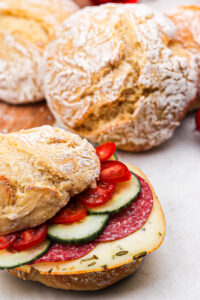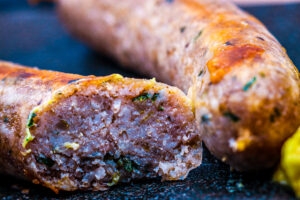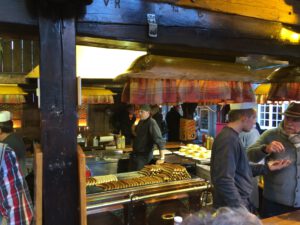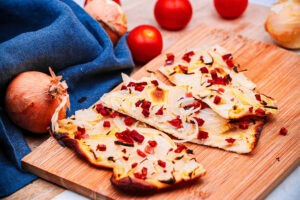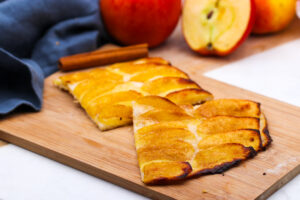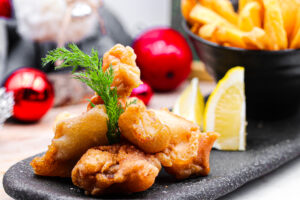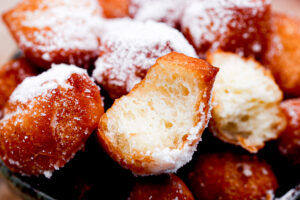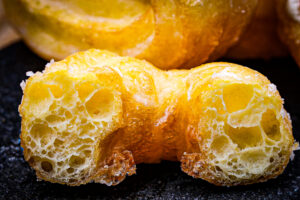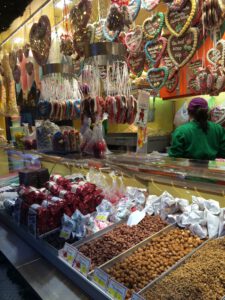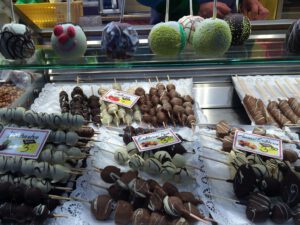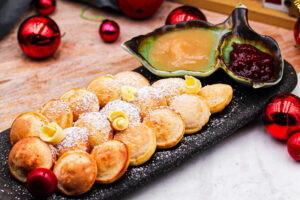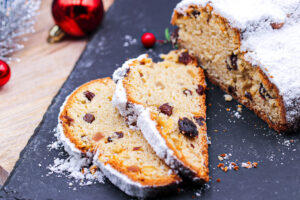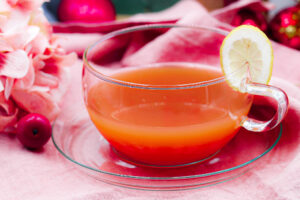Hanna&Mama
Cooking&Baking
12.2022
Traditional German X-Mas Market
Welcome to this year’s Christmas Special. This year to thank you for 2022, I have prepared an extra large XXL menu for my students with almost double the usual number of recipes and pages; 20 recipes are explained in detail over about 100 pages!
This year’s theme is the traditional German Christmas market.
During Advent (about four weeks before December 24) and sometimes even for a few days after Christmas, Christmas markets are held in many regions. Depending on the region, they are sometimes called Advent markets or Christkindlmarkets. Christmas markets are a very popular event known to all Germans. Children and adults alike visit Christmas markets many times during the holiday season. They are a traditional part of the German Christmas season.
It is difficult to quantify the number of Christmas markets. In Germany alone, there are between 2,000 and 3,000 Christmas markets, large and small, that last from one day to several weeks. They usually take place at markets in towns large and small. However, small traditional Christmas markets held in churches, castles, farms, etc. are also popular. Christmas markets sell special items such as woolen socks, glassware, jewelry and other handicrafts, Christmas decorations, food and drink. Many Christmas markets also offer attractions such as rides, music, nativity plays, and other performances.
The Christmas traditions of German-speaking countries are known throughout the world, and Christmas markets modeled after them are held in many countries. The most famous and popular Christmas markets in Germany for tourists are in Dresden, Augsburg, Nuremberg, and Bremen.
The origins of Christmas markets date back to the late Middle Ages, when one-day markets were held to stock up on meat and winter clothing at the beginning of the cold season. Some stalls sold roasted chestnuts, nuts, and almonds.
The Christmas market is lined with a variety of small stalls. There are drinks such as hot wine, meat and fish dishes such as grilled sausages and steaks, and sweet dishes such as chocolate fruit and French crullers. With this menu, you can create the perfect Christmas market yourself at home. Most of the dishes on this menu are classic favorites found at German Christmas markets. Since Christmas is a time to spend with family, there are many simple recipes such as chocolate fruit and gingerbread hearts that can be made alone or very well with friends and children. With these, you can share the joy of Christmas with many people. You can also make little delicious Christmas gifts with many recipes, such as Stollen or delicious crunchy caramel almonds. And for those who prefer salty to sweet, there are plenty of delicious recipes for a wonderful Christmas party. For example, French fries can be served with a variety of dips, or a light dinner can be enjoyed with a crispy tart flambé.
You WANT...
to know what you will get how to book a class how to download how to watch videos how to Zoom class schedule
to know about me about Konagami about Contact about Policies
recipes
The name “rose roll” comes from the shape of the bread roll. When baked, the special shape of the bread rolls makes them unfold like a rose flower, hence the name rose rolls. There are many different recipes, some with sourdough, some without, some with rye flour, and some with sunflower seeds.
Potato rose rolls are made with lots of potatoes in the dough and baked with spelt flour. This makes the rolls very moist, fluffy, and healthy. You can enjoy them in a variety of ways, not only with cheese and ham, but also with jam, chocolate cream, etc. Freshly baked rolls are delicious for breakfast, sandwiches for hiking, lunch boxes, or as a side dish for soups and salads.
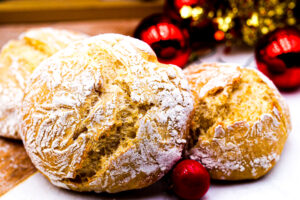
Grilled sausages of all sizes are also a favorite at Christmas markets. Grilled sausages are usually made only with pork. Because these grilled sausages are made with pork and chicken, they are milder sausages. Chicken sausages are especially popular among women because they are healthier than pure pork sausages. They are usually lower in calories, lower in cholesterol, and richer in vitamins and minerals.
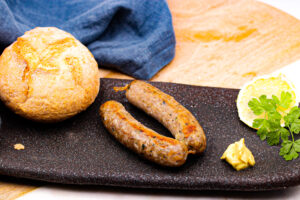
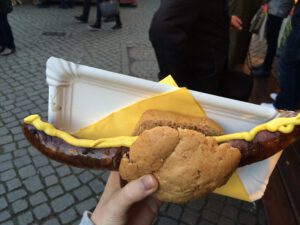
When you go to a German fair or Christmas market, you will always find not only sweet dishes and grilled sausages, but also grilled garlic mushrooms. Many Germans go to a Christmas market at least once during the season and definitely want to eat grilled garlic mushrooms. They are brown, juicy fried mushrooms with plenty of garlic, sweet onion rings, lots of garlic sauce, and bread on the side.
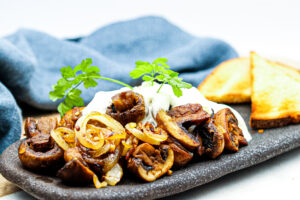
Flammkuchen is a French tart flambé cake, a specialty of Alsace and neighboring Lorraine in France and the German provinces of Saarland, Palatinate, and Baden.
Today, there are countless recipes. For example, tarte flambée is made with Camembert, goat cheese, pumpkin, figs, tomatoes, and salami. The basis of the classic Alsatian tarte flambée is a very thinly spread bread dough. The traditional topping is a layer of cream with raw onions, bacon, and sour cream, lightly seasoned with salt and pepper. The dough is then baked briefly in a high-heat oven.
In the past, flammkuchen were baked in a wood-fired oven before the bread to take advantage of the initial high heat. It was also a way of knowing the temperature of the oven. If it blackened quickly, the bread had to be added after the oven had cooled a bit. If the tarte flambée needed to be baked longer, it had to be reheated. The name “Flammkuchen” came from the fact that the oven flame had not yet completely extinguished when it was inserted. “Flamm” means flame and “Kuchen” means cake.
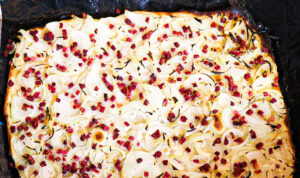
In addition to the classic Alsatian tarte flambée, there are many other recipes. One idea is to arrange it with thinly sliced apples, cinnamon, and sugar. If you have a large oven, you can easily prepare a main course along with the dessert, for example, by baking an Alsatian tarte flambée and an apple tarte flambée at the same time.
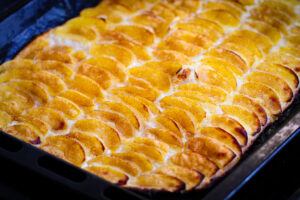
Whenever you go to a Christmas market, you will always find a stall selling Dutch fries. What makes Dutch fries unique is the wide variety of potato sauces. Depending on the store, there are usually about 15 different sauces to choose from. They include curry, mushroom, cheese, sweet, dry, and sour. In Germany, french fries with mayonnaise or ketchup are very popular. This menu shows you how to make four popular sauces for French fries quickly and easily. These completely different sauce variations give french fries a whole new taste and add to the fun of making your own french fries at home with family and friends. This transforms a simple snack food into a dish that can be prepared with many delicious dips and enjoyed at a party or at home watching a movie, for example.
When you buy French fries in Japan, they are usually just seasoned with salt or nori. In Germany, french fries are always seasoned with special spices for french fries. There are many different recipes. The main ingredient is always salt. Paprika powder is also often used. In this recipe, I present several spice mix variations so that you can make the most delicious french fries for yourself and your family.
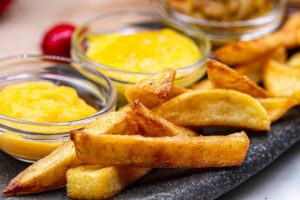
In the Netherlands and Belgium, french fries are served with a variety of sauces. It is quite common to find many different types of dips to go with French fries. One of the most popular sauces for French fries is Sauce Andalouse. This dip is based on mayonnaise and tomato paste or ketchup. It is very mild and very popular with children.
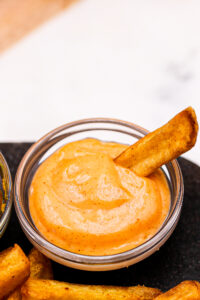
Joppi sauce (Dutch: Joppiesaus) is a Dutch cold yellow sauce made with mayonnaise, onions and curry spices. It is mainly served with french fries and various snacks. In the Netherlands, french fries with joppi sauce are called “pataje joppi”.
In the Netherlands, yoppi sauce is sold in most stalls and in some supermarkets. Outside of the Netherlands, it is sold mainly in snack bars specializing in Dutch fries. In the border area with the Netherlands, it is also sold in many French fry stores and supermarkets.
Yoppi Sauce was invented and marketed by Janne de Jager, nicknamed “Yoppi,” at Annie’s Snack Bar, a fast food restaurant in Granelburg, the Netherlands, in 2002 or 2003. 2010, the Dutch potato chips brand “Lay’s has made the Patatje Joppie variety one of its staple products since an advertising campaign soliciting suggestions for new flavors.
This sauce is also very tasty with vegetable sticks, for example, carrot sticks.

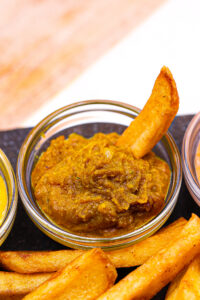
Peanut sauce is called “satesaus” or “pindasaus” in Dutch.
In the Netherlands, peanut sauce is an essential ingredient in many dishes. Although it originated in Asia, it has long been served with French fries and other foods in the Netherlands. The sauce is usually made hot and poured over fries in the same way as mayo. Friet Sate” or “Friet Pinda” (French fries with peanut sauce) is sold not only in the Netherlands, but also in the Kingdom of Belgium. This sauce can be bought in supermarkets and is very popular.
The peanut sauce tastes very good not only on fries, but also on grilled chicken.
Cheese sauce goes very well not only with pasta, but also with French fries. It is one of the most popular sauces at Christmas market stalls selling Dutch fries. However, this sauce is also very tasty on tacos, as hamburger sauce, and vegetable sticks.
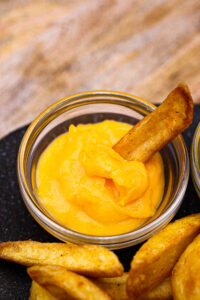
Fried fish, called “backfish,” is not only sold at all festivals and Christmas markets in northern Germany, but also at harbors and beaches for tourists. Especially in North German fish restaurants, baked fish, such as pollock or other large fish fried in beer batter, can be served with boiled potatoes, lemon and tartar sauce. If you buy baked fish from a small stall at a Christmas market, the small pieces of fish are turned in beer batter like chicken nuggets and deep fried until crispy. They are sold in bags with french fries and tartar sauce, just like fish and chips in England.
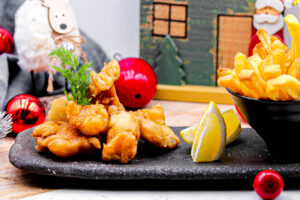
If you go to a Christmas market in northern Germany, you will always find a stall selling fish rolls. They are simple bread rolls, such as Kaiser rolls or rose roll bread, filled with lettuce, cucumbers, various kinds of smoked fish or fish hamburger steaks. The most popular is the fish hamburger, a fish roll made with fish burgers. Most famous is the Hamburg Fish Hamburger with a juicy, simply seasoned fish hamburger steak. The only sauce used for the original Hamburg Fish Hamburger is tartar sauce.
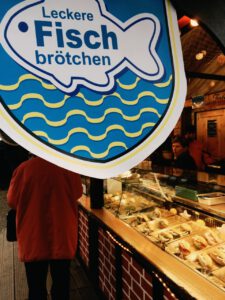
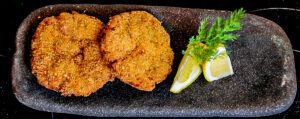
Germans do not like to fry food at home, but they do like to eat fried food, so there are many fried dishes at Christmas markets. Germans are especially fond of fried desserts. One of the most typical fried desserts is “Schmaltzkuchen,” also known as “Mutzen” in northern Germany. They are very small, crispy on the outside and very fluffy on the inside, like a light, juicy, bite-sized miniature doughnut. They are eaten while they are still warm, with lots of icing sugar. We often buy one portion and share it with friends and family.
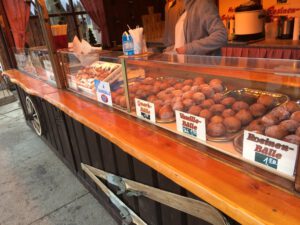
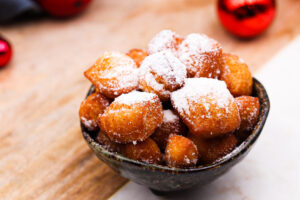
“Spritzkuchen” are also known in English as “French crullers.” It is a very popular variation of the traditional German doughnut. Spritzkuchen are made by frying choux pastry in hot oil. The basic style is to spread a thin layer of icing over the freshly baked Spritzkuchen. However, nowadays, if you want a less sweet and less sticky version, you can simply sprinkle icing sugar over the top. If you like Mr. Donut or French crullers, you can easily bake your own using this recipe, fill with angel cream and glaze with chocolate.
Usually the stalls that also make Schmaltzkuchen also sell French Crullers.
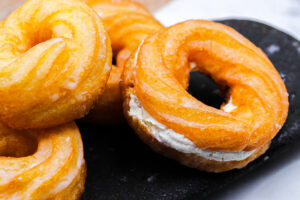
One of the sweets that can be found at every Christmas market, large or small, is caramel almonds. For all Germans, young and old, the smell of caramelized almonds is the true scent of Christmas. Caramel almonds are slowly caramelized in a pan with lots of sugar, water, and Christmas spices to create a thin layer of crunchy, brown caramel on the outside. While the caramel almonds are classically made with almonds, variations using sunflower seeds, coarsely chopped coconut, hazelnuts, and other ingredients are now sold at street stalls.

Next to Stollen, the most famous and popular German Christmas cake in the world is gingerbread, or ” Lebkuchen,” which is a small, spiced, honey cake made of honey.
Although the first literary evidence of the small spiced honey cake dates back to around 350 B.C., honey cakes were already known in ancient Egypt, as evidenced by grave goods.
Gingerbread as we know it today was originally invented in Dinan, Belgium, and later adopted by the people of Aachen, Germany, who refined it into the gingerbread recipe “Aachener Printern. Gingerbread has been baked in men’s monasteries since the 14th century. Gingerbread was popular because it kept well and was distributed by the monks in bad times.
The introduction of baking powder at the end of the 19th century also influenced the development of gingerbread. Baking powder made the spicy dough rise. This led to many new variations.
One of these variations of gingerbread is the gingerbread heart. They can be purchased not only at Christmas markets, but also at all festivals throughout the year, including Oktoberfest. Small or large thick hearts are baked from gingerbread and decorated with colorful icing. Short messages are written in icing, such as “best mom,” “I love you,” “princess,” and so on. The hearts can be hung with ribbon or used as a necklace to hang around the neck when walking through the Christmas market as is after purchase.
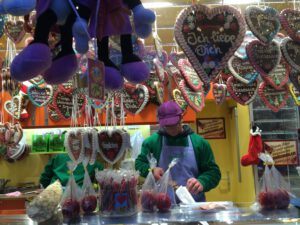
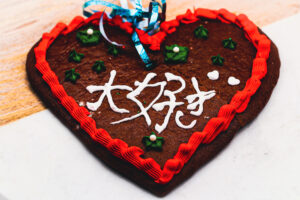
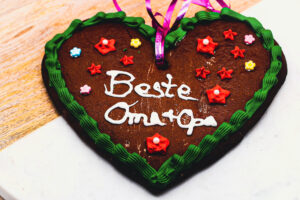

Many of the stalls selling sweet treats at Christmas markets sell many varieties of sweet treats at the same time. Usually, cotton candy, gingerbread hearts, haribo, caramel almonds in various variations, and chocolate fruits are all available at the same stall.
Chocolate fruits are usually sold with red caramel-colored love apples and are very popular with adults as well as children. Various fruits, mostly bananas, grapes, and strawberries, are placed on skewers and coated with chocolate. The recipe is very tasty and easy to make yourself. You can decorate the chocolate with sprinkles of your choice, so this recipe is very easy to make with small children or for a party night at home with friends. Everyone can decorate them by skewering their favorite fruit and glazing them with their favorite chocolate. They also make a great snack for children’s birthday parties.


Poffertje, or Dutch mini pancakes, are sold mainly at fairs and Christmas markets in northern Germany. Due to its closeness to Holland, it is a very popular dessert in Northern Germany. In the Netherlands, Poffertjes have existed since the 17th century. Even back then, it was mainly sold as street food and was a popular menu item at fairs. Today, you can buy Poffertje anywhere in the Netherlands all year round. In supermarkets in the Netherlands and northern Germany, you can even buy them frozen, so all you have to do is heat them up in the microwave. Just like crepes, you can buy Poffertje with countless toppings at Christmas markets. Butter and icing sugar or chocolate sauce and bananas are popular. There are special baking molds for poffertjes, but this recipe introduces mini pancakes that can be easily and quickly cooked in a Japanese takoyaki pan. They also make a great dessert to end a tacopa.
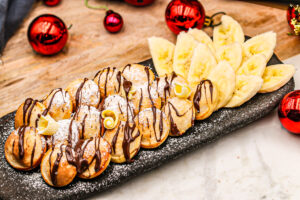
In the past, I have taught a different new Stollen recipe every year. This year, I have prepared a new recipe again.
Since the 14th century, it is documented that Stollen has been a tradition in Germany. Nowadays there are many different recipes. Stollen are usually baked with a yeast dough with raisins and Christmas spices.
What is special about this year’s stollen recipe is that it is juicier, quicker, and easier to make than other traditional stollen recipes. Because this Stollen is baked with baking powder instead of yeast, the dough does not need to rest and can be baked immediately after forming. The dough is made with lots of cottage cheese, which makes it juicier and fluffier, and the flavors of each ingredient blend very well during baking. Therefore, they can be eaten immediately after baking, without the need to let them rest for several days like standard stollen.
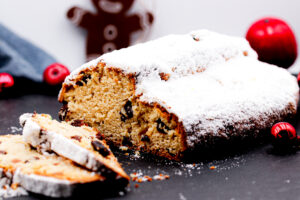
During the Christmas season, there are many typical Christmas drinks. There are also many types of beverages at Christmas markets, mostly alcoholic beverages. The most popular is the classic hot wine. In recent years, I have already taught many different variations of hot wine. But there are also Christmas drinks for children. Instead of wine, I use red fruit tea and make a delicious non-alcoholic Christmas punch with lots of juice and spices.
DATE
17 & 23 Dec 2022
In this time period you will have 2 days with Zoom Meetings for asking the teacher questions, meeting with other students and cook and bake LIVE together.
- Potato Rose Buns
- Hamburg Fish Burger
- Alsatian Tarte Flambée
- Apple Tarte Flambée
- Roasted Caramel Almonds
- Cottage Cheese Stollen
TIME
3:00 PM – 7:15 PM
Tokio, Japan, local time
ZOOM MEETING TIME
- 3:00 – 5:30 PM: LIVE Class
- 5:30 – 6:15 PM: Break Time
- 6:15 – 7:15 PM: LIVE Class
Zoom Room OPEN
In the time period of the LIVE Class you can enter and connect to the teacher and other students; choose your day and time freely.
The Zoom classes will get recorded for those, who cannot participate or want to listen to the teacher`s advise again.
During the Break Time you can bake the Stollen and prepare all ingredients for the second half of the class.
COST
6900 Yen
Recipe Download
You need your RECIPE DOWNLOAD PASSWORD for access!!
You can find it in your mail with the class details or on the "How to ...?" page of your recipe.
Click Here
Video Turorials
You need your VIDEO PAGE PASSWORD for access!!
You can find it in your mail with the class details or on the "How to ...?" page of your recipe.
Click Here

